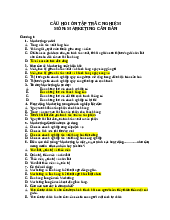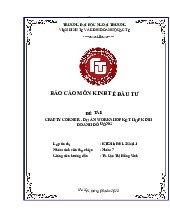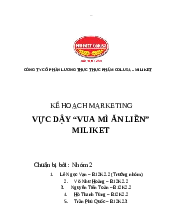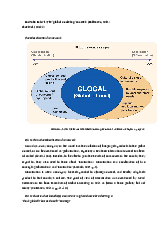
lOMoARcPSD|44862240
lOMoARcPSD|44862240
Chapter 5 Consumer Markets and Consumer Buyer Behavior
1) ________ is never simple, yet understanding it is the essential task of marketing management.
A) Brand personality
B) Consumption pioneering
C) Early adoption
D) Consumer buying behavior
E) Understanding the difference between primary and secondary data
Answer: D
Diff: 1 Page Ref: 135
Skill: Concept
Objective: 5-1
2) The consumer market is made up of which of the following?
A) individuals who acquire goods or services for personal consumption
B) households that purchase goods or services for personal consumption
C) businesses that purchase goods and services
D) A and B
E) all of the above
Answer: D
Diff: 2 Page Ref: 135
Skill: Concept
Objective: 5-1
3) Economic, technological, and cultural forces are all ________ in the stimulus-response model
of buyer behavior. A) buyer responses
B) stimuli
C) components of the buyer's decision process
D) buyer characteristics
E) buying attitudes
Answer: B
Diff: 2 Page Ref: 137
Skill: Concept
Objective: 5-1 4) Most
large companies research
________ buying
decisions to find out
what they buy, where
they buy, how and how

lOMoARcPSD|44862240
much they buy, when
they buy, and why they
buy.
A) market
B) permanent
C) consumer
D) social
E) group
Answer: C
Diff: 1 Page Ref: 136
Skill: Concept
Objective: 5-1
5) The starting point of understanding a consumer's response to various marketing efforts is the
________ of a buyer's behavior.
A) belief
B) subculture
C) postpurchase feeling
D) stimulus-response model
E) postpurchase dissonance
Answer: D
Diff: 2 Page Ref: 136
Skill: Concept
Objective: 5-1
6) Marketing stimuli consist of the four Ps. Which is NOT one of these?
A) product
B) politics
C) price
D) promotion
E) place
Answer: B
Diff: 2 Page Ref: 136
Skill: Concept
Objective: 5-1 7) The
marketer wants to
understand how the
stimuli are changed into
responses inside the
consumer's ________,
which has two parts.
First, the buyer's
characteristics influence
how he or she perceives

lOMoARcPSD|44862240
and reacts to the stimuli.
Second, the buyer's
decision process itself
affects the buyer's
behavior. A) culture
B) black box
C) belief
D) lifestyle
E) social class
Answer: B
Diff: 2 Page Ref: 136
Skill: Concept
Objective: 5-1
8) In the model of buyer behavior, which of the following is NOT a major type of force or event
in the buyer's environment?
A) economic
B) technological
C) political
D) channel
E) cultural
Answer: D
Diff: 2 Page Ref: 136
Skill: Concept
Objective: 5-1
9) ________ is(are) the most basic cause of a person's wants and behavior.
A) Culture
B) Brand personality
C) Cognitive dissonance
D) Societal factors
E) Selective perception
Answer: A
Diff: 1 Page Ref: 137
Skill: Concept
Objective: 5-2 10)
Marketers are always
trying to spot ________
in order to discover new
products that might be
wanted.
A) lifestyles
B) cultural shifts
C) groups

lOMoARcPSD|44862240
D) dissonance
E) attitudes
Answer: B
Diff: 3 Page Ref: 137
Skill: Concept
Objective: 5-2
11) Each culture contains smaller ________, or groups of people with shared value systems
based on common life experiences and situations.
A) alternative evaluations
B) cognitive dissonances
C) subcultures
D) motives
E) attitudes
Answer: C
Diff: 1 Page Ref: 137
AACSB: Multicultural and Diversity
Skill: Concept
Objective: 5-2
12) Which of the following is NOT considered an important American subculture by marketers?
A) Hispanics
B) African Americans
C) mature consumers
D) opinion leaders
E) Asian Americans
Answer: D
Diff: 2 Page Ref: 137
AACSB: Multicultural and Diversity
Skill: Concept
Objective: 5-2 13) This
group of consumers
tends to buy more
branded, higher-quality
products. and to make
shopping a family event,
with children having a
big say in the purchase
decision. In general, they
are very brand loyal, and
they favor companies
who show special
interest in them.
A) Hispanic

lOMoARcPSD|44862240
B) African American
C) Asian
D) mature
E) gay and lesbian
Answer: A
Diff: 3 Page Ref: 137-138
AACSB: Multicultural and Diversity
Skill: Concept
Objective: 5-2
14) ________, the fastest-growing U.S. demographic segment, now number more than 45
million.
A) African Americans
B) Hispanics
C) Asian Americans
D) Mature consumers
E) Gays and lesbians
Answer: B
Diff: 3 Page Ref: 137
AACSB: Multicultural and Diversity
Skill: Concept
Objective: 5-2
15) Although more price-conscious than other segments, ________ consumers tend to be
strongly motivated by quality and selection. Brands are important. They enjoy shopping and are
more fashion conscious than other ethnic groups.
A) Hispanic
B) African American
C) mature
D) Asian
E) baby boomer
Answer: B
Diff: 3 Page Ref: 139
AACSB: Multicultural and Diversity
Skill: Concept
Objective: 5-2 16)
________, the most
affluent American
demographic subculture,
now have more than
$450 billion in annual
spending power.
A) Hispanics
B) African Americans

lOMoARcPSD|44862240
C) Asian Americans
D) Gays and lesbians
E) Gen Xers
Answer: C
Diff: 3 Page Ref: 139
AACSB: Multicultural and Diversity
Skill: Concept
Objective: 5-2
17) ________ are becoming a very attractive market: they are the ideal market for travel,
restaurants, high-tech home entertainment products, and convenient services
A) Hispanics
B) Asian Americans
C) Mature consumers
D) African Americans
E) Teenagers
Answer: C
Diff: 2 Page Ref: 140
AACSB: Multicultural and Diversity
Skill: Concept
Objective: 5-2
18) Which of the following is NOT true of mature consumers?
A) The best strategy is to appeal to their active, multidimensional lives.
B) They are an ideal market for "do-it-for-me" services.
C) High-tech home entertainment products appeal to them.
D) They place more importance on brand names and are more brand loyal than members of
otherage groups.
E) They are a good market for cosmetics and personal care products.
Answer: D
Diff: 2 Page Ref: 140
AACSB: Multicultural and Diversity
Skill: Concept
Objective: 5-2 19)
________ are society's
relatively permanent and
ordered divisions whose
members share similar
values, interests, and
behaviors.
A) Social classes
B) Cultures
C) Reference groups
D) Attitudes

lOMoARcPSD|44862240
E) Lifestyles
Answer: A
Diff: 1 Page Ref: 140
Skill: Concept
Objective: 5-2
20) What is one way that social class is NOT measured?
A) occupation
B) education
C) income
D) number of children in the family
E) wealth
Answer: D
Diff: 2 Page Ref: 140
Skill: Concept
Objective: 5-2
21) Which of the following statements is true regarding social class in the United States?
A) Social class is determined primarily by income level.
B) Lines between social classes in the United States are fixed and rigid.
C) Social classes show distinct product preferences in clothing and automobiles.
D) Wealth is more critical than education level in measuring social class.
E) People are relegated to a permanent class layer in the United States.
Answer: C
Diff: 3 Page Ref: 140
AACSB: Multicultural and Diversity
Skill: Concept
Objective: 5-2
22) ________ are groups to which an individual wishes to belong, as when a teenaged basketball
player hopes to play someday for the Los Angeles Lakers.
A) Membership groups
B) Aspirational groups
C) Leading adopter groups
D) Leisure groups
E) Social class groups
Answer: B
Diff: 2 Page Ref: 140
Skill: Concept
Objective: 5-2 23)
________ are people
within a reference group
who, because of special
skills, knowledge,

lOMoARcPSD|44862240
personality, or other
characteristics, exert
influence on others.
A) Opinion leaders
B) Habitual buyers
C) Social networkers
D) Stealth marketers
E) Buzz marketers
Answer: A
Diff: 1 Page Ref: 141
AACSB: Communication
Skill: Concept
Objective: 5-2
24) Opinion leaders are sometimes referred to as ________.
A) the influentials
B) the upper uppers
C) the middle class
D) buzz marketers
E) networkers
Answer: A
Diff: 3 Page Ref: 141
AACSB: Communication
Skill: Concept
Objective: 5-2
25) Many companies, such as JetBlue and Sony, enlist everyday consumers who are enthusiastic
about their brands to become ________ , brand ambassadors who share their passion for a
company's products with large circles of friends and acquaintances in return for insider
knowledge and other rewards.
A) leading adopters
B) brand evangelists
C) direct marketers
D) direct sellers
E) influencers
Answer: B
Diff: 2 Page Ref: 141
AACSB: Communication
Skill: Concept
Objective: 5-2 26)
Companies who use
brand ambassadors are
participating in
________.

lOMoARcPSD|44862240
A) opinion leading
B) traditional marketing
C) buzz marketing
D) direct marketing
E) values marketing
Answer: C
Diff: 2 Page Ref: 141
AACSB: Communication
Skill: Concept
Objective: 5-2
27) MySpace.com and YouTube are both examples of ________.
A) buzz marketing
B) opinion leaders
C) social networks
D) early adopters
E) word-of-mouth marketing
Answer: C
Diff: 2 Page Ref: 143
AACSB: Use of IT
Skill: Concept
Objective: 5-2
28) Which of the following best explains why a rush of marketers now participate in established
online social networks?
A) Social networking has been proven to be more effective than traditional marketing.
B) Social networks allow companies to have greater control over brand-related content than
other media do.
C) Members of social networking sites are unlikely to tune out personalized advertising
messages.
D) Companies have found their own social networks to be unsuccessful.
E) Consumers are more likely to view to peer-to-peer communication as credible. Answer: E
Diff: 3 Page Ref: 144
AACSB: Communication
Skill: Concept
Objective: 5-2 29) The
________ is the most
important consumer
buying organization in
society; the roles and
influences of different
members have been
researched extensively.
A) family

lOMoARcPSD|44862240
B) social class
C) membership group
D) subculture
E) reference group
Answer: A
Diff: 2 Page Ref: 145
Skill: Concept
Objective: 5-2
30) A ________ consists of the activities people are expected to perform according to the
persons around them.
A) motive
B) role
C) lifestyle
D) life cycle
E) tradition
Answer: B
Diff: 2 Page Ref: 146
Skill: Concept
Objective: 5-2
31) A buyer's decisions are influenced by ________ such as the buyer's age and life-cycle stage,
occupation, economic situation, lifestyle, and personality and self-concept.
A) personal characteristics
B) reference groups
C) perceptions
D) attitudes
E) psychographics
Answer: A
Diff: 2 Page Ref: 146
Skill: Concept
Objective: 5-2
32) People change the goods and services they buy over time because of the two changing
factors of ________. A) belief and attitude
B) perception and personality
C) age and life-cycle stage
D) groups and learning
E) family and tradition
Answer: C
Diff: 2 Page Ref: 146
Skill: Concept
Objective: 5-2 33)
________ is a person's

lOMoARcPSD|44862240
pattern of living as
expressed in his or her
psychographics,
including his or her
activities, interests, and
opinions.
A) Personality
B) Culture
C) Lifestyle
D) Motive
E) Social class
Answer: C
Diff: 1 Page Ref: 147
Skill: Concept
Objective: 5-2
34) All of the following make up a person's lifestyle EXCEPT ________.
A) AIO dimensions
B) interests
C) dissonance-reducing buying behavior
D) opinions
E) work
Answer: C
Diff: 2 Page Ref: 147
Skill: Concept
Objective: 5-2
35) A customer's lifestyle can be measured by using the AIO dimensions. What does AIO stand
for?
A) Activities, Interests, Opinions
B) Achievement, Involvement, Organizations
C) Accommodation, Investment, Orientation
D) Acknowledgements, Interests, Observations
E) Adoptions, Interests, Occupations
Answer: A
Diff: 2 Page Ref: 147
Skill: Concept
Objective: 5-2 36)
________ refers to the
unique psychological
characteristics that lead
to relatively consistent
and lasting responses to
one's own environment.

lOMoARcPSD|44862240
It is usually described in
traits such as
selfconfidence,
dominance, sociability,
autonomy,
defensiveness,
adaptability, and
aggressiveness. A)
Alternative evaluation
B) Belief
C) Culture
D) Personality
E) Self-awareness
Answer: D
Diff: 1 Page Ref: 148
Skill: Concept
Objective: 5-2
37) Researchers found that a number of well-known brands tended to be strongly associated with
one particular trait, such as Jeep with "ruggedness." Which of the following terms would a
marketer use to describe a specific mix of human traits that may be attributed to a particular
brand?
A) brand perception
B) product image
C) brand personality
D) brand concept
E) brand equity
Answer: C
Diff: 1 Page Ref: 148
Skill: Concept
Objective: 5-2
38) Brand personality is a mix of human traits attributed to a brand. Which of the following is
NOT a brand personality trait as discussed in your text?
A) sincerity
B) excitement
C) competence
D) sophistication
E) emotion
Answer: E
Diff: 3 Page Ref: 148
Skill: Concept
Objective: 5-2 39) A
person's buying choices

lOMoARcPSD|44862240
are influenced by four
major psychological
factors. Which is NOT
one of these factors?
A) motivation
B) perception
C) alternative evaluation
D) learningE) beliefs
Answer: C
Diff: 2 Page Ref: 148
Skill: Concept
Objective: 5-2
40) A ________ is a need that is sufficiently pressing to direct a person to seek satisfaction.
A) stimulus
B) perception
C) culture
D) motive
E) tradition
Answer: D
Diff: 1 Page Ref: 148
Skill: Concept
Objective: 5-2
41) Many marketers use the self-concept premise that people's possessions contribute to and
reflect their identities; that is, "we are what we have." Under this premise, consumers ________.
A) buy products to support their self-images B) use brand personalities
C) are affected by subconscious motivations
D) are attracted to products that fit in with their existing attitudes
E) conduct the information searchAnswer: A
Diff: 2 Page Ref: 148
Skill: Concept
Objective: 5-2
42) According to Freud's theories, people are ________ many of the psychological forces
shaping their behavior.
A) unaware of
B) unsure of
C) aware of
D) status-driven about
E) socially conscious of
Answer: A
Diff: 2 Page Ref: 149

lOMoARcPSD|44862240
Skill: Concept
Objective: 5-2 43) The
term ________ refers to
qualitative research
designed to probe
consumers' hidden,
subconscious
motivations.
A) perception analysis
B) opinion leader
C) motivation research
D) need recognition investigation
E) depth research technique
Answer: C
Diff: 2 Page Ref: 149
Skill: Concept
Objective: 5-2
44) Maslow's theory is that ________ can be arranged in a hierarchy.
A) stimuli
B) beliefs and attitudes
C) perceptions
D) human needs
E) decisions
Answer: D
Diff: 1 Page Ref: 149
Skill: Concept
Objective: 5-2
45) Which of the following is NOT part of Maslow's Hierarchy of Needs?
A) physiological needs
B) safety needs
C) stimulus needs
D) self-actualization needs
E) social needs
Answer: C
Diff: 2 Page Ref: 149
Skill: Concept
Objective: 5-2
46) What is the LEAST pressing in Maslow's Hierarchy of Needs?
A) physiological needs
B) social needs
C) esteem needs

lOMoARcPSD|44862240
D) self-actualization needs
E) safety needs
Answer: D
Diff: 2 Page Ref: 149
Skill: Concept
Objective: 5-2 47)
________ is the process
by which people select,
organize, and interpret
information to form a
meaningful picture of the
world.
A) Personality
B) Perception
C) Selective grouping
D) Learning
E) Self-actualization
Answer: B
Diff: 2 Page Ref: 150
AACSB: Communication
Skill: Concept
Objective: 5-2
48) People cannot focus on all of the stimuli that surround them each day. A person's tendency to
screen out most of the information to which he or she is exposed is called ________.
A) selective retention
B) selective distortion
C) selective attitude
D) selective attention
E) selective perception
Answer: D
Diff: 2 Page Ref: 150
AACSB: Communication
Skill: Concept
Objective: 5-2
49) People tend to interpret new information in a way that will support what they already believe.
This is called ________.
A) selective retention
B) selective distortion
C) selective attitude
D) selective attention
E) selective perception
Answer: B

lOMoARcPSD|44862240
Diff: 2 Page Ref: 150
AACSB: Communication
Skill: Concept
Objective: 5-2 50)
People forget much that
they learn. They tend to
retain information that
supports their attitudes
and beliefs. This is
called ________.
A) selective attention
B) selective retention
C) selective attitude
D) selective distortion
E) perceptual vigilance
Answer: B
Diff: 2 Page Ref: 150
AACSB: Communication
Skill: Concept
Objective: 5-2
51) Some consumers worry that they will be affected by marketing messages without even
knowing it. They are concerned about ________ advertising.
A) alternative evaluation
B) subliminal
C) perceptual
D) innovative
E) comparative
Answer: B
Diff: 2 Page Ref: 150
AACSB: Communication
Skill: Concept
Objective: 5-2
52) ________ describes changes in an individual's behavior arising from experience.
A) Lifestyle
B) Learning
C) Perception
D) Cognitive dissonance
E) Aggressiveness
Answer: B
Diff: 1 Page Ref: 151
Skill: Concept
Objective: 5-2 53)

lOMoARcPSD|44862240
Learning occurs through
the interplay of all of the
following EXCEPT
________. A) drives
B) stimuli
C) cues
D) dissonance behavior
E) reinforcement
Answer: D
Diff: 2 Page Ref: 151
Skill: Concept
Objective: 5-2
54) ________ are subtle stimuli that determine where, when, and how a person responds to an
idea.
A) Cues
B) Drives
C) Messages
D) Personalities
E) Impulses
Answer: A
Diff: 2 Page Ref: 151
AACSB: Communication
Skill: Concept
Objective: 5-2
55) If a consumer's experience is rewarding, that consumer will probably use the product more
and more. The consumer's response to the product will be ________.
A) an attitude
B) a belief
C) reinforced
D) a dissonant experience
E) motivated
Answer: C
Diff: 2 Page Ref: 151
Skill: Concept
Objective: 5-2 56)
Applying ________,
marketers can affect
demand for a product by
associating it with strong
drives, using motivating
cues, and providing
positive reinforcement.

lOMoARcPSD|44862240
A) subliminal advertising
B) social classes
C) learning theory
D) need recognition
E) cognitive dissonance
Answer: C
Diff: 2 Page Ref: 151
AACSB: Communication
Skill: Concept
Objective: 5-2
57) A(n) ________ is a descriptive thought that a person has about something.
A) lifestyle
B) motive
C) belief
D) attitude
E) perception
Answer: C
Diff: 1 Page Ref: 151
Skill: Concept
Objective: 5-2
58) A(n) ________ is a person's relatively consistent evaluations, feelings, and tendencies toward
an object or idea.
A) lifestyle
B) motive
C) belief
D) attitude
E) perception
Answer: D
Diff: 1 Page Ref: 151
Skill: Concept
Objective: 5-2 59) A
person's attitudes fit into
a pattern, and to change
one attitude may require
difficult adjustments in
many others. Thus, a
company should
________ try to fit its
products into existing
attitudes rather than
attempt to change
attitudes.

lOMoARcPSD|44862240
A) usually
B) not
C) once in a while
D) seldom
E) never
Answer: A
Diff: 1 Page Ref: 151
Skill: Concept
Objective: 5-2
60) When consumers are highly involved with the purchase of an expensive product and they
perceive significant differences among brands, they most likely will undertake ________.
A) habitual buying behavior
B) complex buying behavior
C) reflective buying behavior
D) habitual buying behavior
E) variety-seeking buying behavior
Answer: B
Diff: 2 Page Ref: 152
Skill: Concept
Objective: 5-3
61) Which of the following typically occurs with habitual buying behavior?
A) There is high consumer involvement.
B) There is strong brand loyalty.
C) Consumers search extensively for information.
D) Ad repetition creates brand conviction.
E) none of the above
Answer: E
Diff: 2 Page Ref: 152
Skill: Concept
Objective: 5-3 62)
When customers have a
low involvement in a
purchase but perceive
significant brand
differences, they will
most likely engage in
________.
A) complex buying behavior
B) dissonance-reducing buying behavior
C) habitual buying behavior
D) variety-seeking buying behavior
E) brand conviction buying behavior

lOMoARcPSD|44862240
Answer: D
Diff: 2 Page Ref: 153
Skill: Concept
Objective: 5-3
63) The buyer decision process consists of five stages. Which of the following is NOT one
of these stages? A) need recognition
B) information search
C) variety-seeking buying behavior
D) purchase decision
E) postpurchase behavior
Answer: C
Diff: 1 Page Ref: 153
Skill: Concept
Objective: 5-3
64) The buying process starts with ________, in which the buyer recognizes a problem.
A) need recognition
B) information search
C) product awareness
D) product interest
E) alternative evaluationAnswer: A
Diff: 1 Page Ref: 154
Skill: Concept
Objective: 5-3 65) If the
consumer's drive is
strong and a satisfying
product is near at hand,
the consumer is likely to
buy it then. If not, the
consumer may store the
need in memory or
undertake a(n)
________.
A) brand personality
B) alternative evaluation
C) postpurchase behavior
D) information search
E) product adoption
Answer: D
Diff: 3 Page Ref: 154
Skill: Concept
Objective: 5-3
Bấm Tải xuống để xem toàn bộ.




